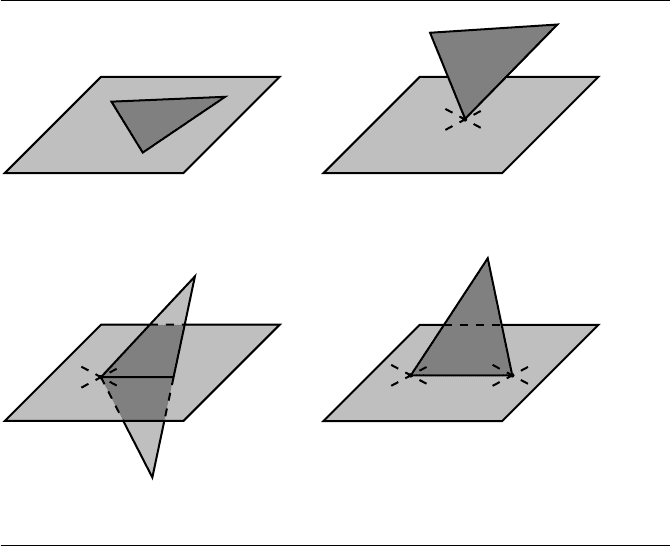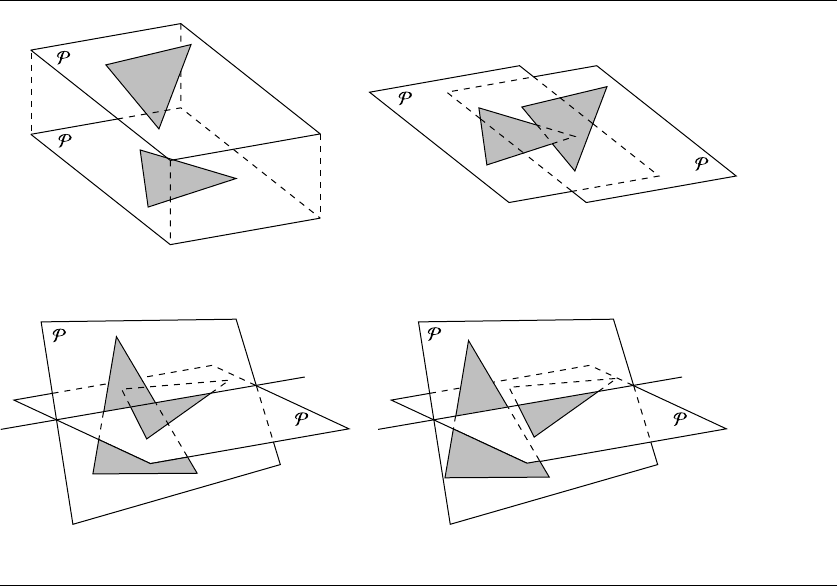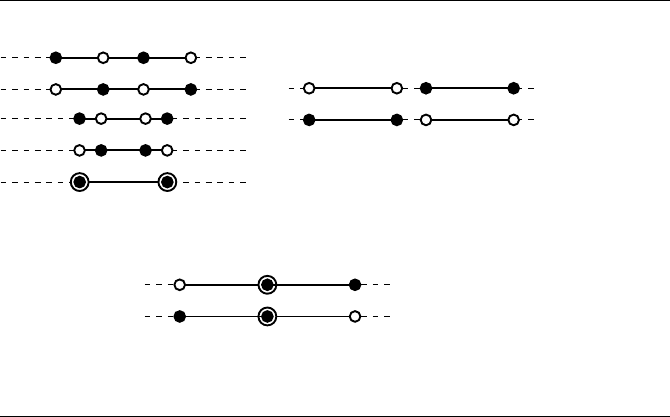Schneider P., Eberly D.H. Geometric Tools for Computer Graphics
Подождите немного. Документ загружается.


534 Chapter 11 Intersection in 3D
If our planes instead are represented explicitly
P
0
: a
0
x +b
0
y +c
0
z + d
0
= 0
P
1
: a
1
x +b
1
y +c
1
z + d
1
= 0
P
2
: a
2
x +b
2
y +c
2
z + d
2
= 0
then we can view the problem as solving three simultaneous linear equations. A
technique such as Gaussian elimination or Cramer’s rule (see Section 2.7.4) can be
invoked to solve this. Bowyer and Woodwark (1983) condense this as follows: let
BC = b
1
c
2
− b
2
c
1
AC =a
1
c
2
− a
2
c
1
AB = a
1
b
2
− a
2
b
1
DC = d
1
c
2
− d
2
c
1
DB = d
1
b
2
− d
2
b
1
AD = a
1
d
2
− a
2
d
1
invDet =
1
a
0
BC − b
0
AC −c
0
AB
X = (b
0
DC − d
0
BC − c
0
DB) ∗ invDet
Y = (d
0
AC −a
0
DC − c
0
AD) ∗ invDet
Z = (b
0
AD − a
0
DB − c
0
AB) ∗ invDet
11.5.3 Triangle and Plane
Suppose we have a plane P defined by a point P and normal ˆn, and a triangle T
defined by its three vertices Q
0
, Q
1
, and Q
2
, as shown in Figure 11.25. If the plane
and triangle intersect, then one triangle vertex will be on the opposite side of the plane
than the other two. If we compute the signed distance between each of Q
0
, Q
1
, and
Q
2
and the plane P (see Section10.3.1) and compare their signs, we can immediately
determine if an intersection exists. Without loss of generality, assume that Q
0
is
on the side of P opposite Q
1
and Q
2
. Then, the two edges Q
0
Q
1
and Q
0
Q
2
must
intersect P at some points I
0
and I
1
, respectively. The line segment I
0
I
1
is then the
intersection of P and T (see Section 11.1.1).
There are a number of “degenerate” cases that may arise, as shown in Figure 11.26.
All of these involve one or more of the triangle’s vertices being exactly on (or within
1 of) the plane. In Figure 11.26(a), P and T are coplanar, and as such should
probably not be considered an intersection, although the context of the application

11.5 Planar Components 535
P
Q
1
Q
0
Q
2
I
1
I
0
n
ˆ
Figure 11.25 Plane-triangle intersection.
may have to deal with this situation specifically. The cases in Figures 11.26(b) and
11.26(c) can be handled in the same way, by considering that Q
i
coinciding with the
plane not be involved with any intersection. The case in Figure 11.26(d) is somewhat
more interesting, as the “intersection” consists of a definite line segment, just as
in a “normal” intersection; how this is handled depends on the semantics of the
application.
The pseudocode is
bool IntersectionOfTriangleAndPlane(Plane3D p1,Triangle3D tri, p2,
Intersection isect)
{
float dot1, dot2, dot3;
dot1 = Dot(p1.normal, tri.p1 - p1.pointOnPlane);
dot2 = Dot(p1.normal, tri.p2 - p1.pointOnPlane);
dot3 = Dot(p1.normal, tri.p3 - p1.pointOnPlane);
if (fabs(dot1) <= EPSILON) dot1 = 0.0;
if (fabs(dot2) <= EPSILON) dot2 = 0.0;
if (fabs(dot3) <= EPSILON) dot3 = 0.0;

536 Chapter 11 Intersection in 3D
(a) (b)
(d)(c)
Figure 11.26 Plane-triangle intersection configurations.
d1d2 = dot1 * dot2;
d1d3 = dot1 * dot3;
if (d1d2 > 0.0 && d1d3 > 0.0) {
// all points above plane
return false;
} else if (d1d2 < 0.0 && d1d3 < 0.0) {
// all points below plane
return false;
}
if (fabs(dot1) + fabs(dot2) + fabs(dot3) == 0) {
// coplanar case
isect.type = plane;
return true;
}
11.5 Planar Components 537
// Most common intersection
if ((dot1>0&&dot2>0&&dot3<0)||
(dot1<0&&dot2<0&&dot3>0){
isect.type = line;
Line3D l1(tri.p1, tri.p3);
Line3D l2(tri.p2, tri.p3);
Point3D point1, point2;
LineIntersectPlane(plane, l1, point1);
LineIntersectPlane(plane, l2, point2);
isect.line.d = point2 - point1;
isect.line.p = point1;
return true;
}
if ((dot2>0&&dot3>0&&dot1<0)||
(dot2<0&&dot3<0&&dot1>0){
isect.type = line;
Line3D l1(tri.p2, tri.p1);
Line3D l2(tri.p3, tri.p1);
Point3D point1, point2;
LineIntersectPlane(plane, l1, point1);
LineIntersectPlane(plane, l2, point2);
isect.line.d = point2 - point1;
isect.line.p = point1;
return true;
}
if ((dot1>0&&dot3>0&&dot2<0)||
(dot1<0&&dot3<0&&dot2>0){
isect.type = line;
Line3D l1(tri.p1, tri.p2);
Line3D l2(tri.p3, tri.p2);
Point3D point1, point2;
LineIntersectPlane(plane, l1, point1);
LineIntersectPlane(plane, l2, point2);
isect.line.d = point2 - point1;
isect.line.p = point1;
return true;
}
// Case b
if (dot1 == 0 && ((dot2>0&&dot3 > 0) || (dot2<0&&dot3 < 0))) {
isect.type = point;
538 Chapter 11 Intersection in 3D
isect.point = tri.p1;
return true;
}
if (dot2 == 0 && ((dot1>0&&dot3 > 0) || (dot1<0&&dot3 < 0))) {
isect.type = point;
isect.point = tri.p2;
return true;
}
if (dot3 == 0 && ((dot2>0&&dot1 > 0) || (dot2<0&&dot1 < 0))) {
isect.type = point;
isect.point = tri.p3;
return true;
}
// Case c
if (dot1 == 0 && ((dot2>0&&dot3 < 0) || (dot2<0&&dot3 > 0))) {
isect.type = line;
Line3D l1(tri.p3, tri.p2);
Point3D point1;
LineIntersectPlane(plane,l1, point1);
isect.line.d = point1 - tri.p1;
isect.line.p = tri.p1;
return true;
}
if (dot2 == 0 && ((dot1>0&&dot3 < 0) || (dot1<0&&dot3 > 0))) {
isect.type = line;
Line3D l1(tri.p1, tri.p3);
Point3D point1;
LineIntersectPlane(plane,l1, point1);
isect.line.d = point1 - tri.p2;
isect.line.p = tri.p2;
return true;
}
if (dot3 == 0 && ((dot1>0&&dot2 < 0) || (dot1<0&&dot2 > 0))) {
isect.type = line;
Line3D l1(tri.p1, tri.p2);
Point3D point1;
LineIntersectPlane(plane, l1, point1);
isect.line.d = point1 - tri.p3;
isect.line.p = tri.p3;
11.5 Planar Components 539
return true;
}
// Case d
if (dot1 == 0 && dot2 == 0) {
isect.type = line;
isect.line.d = tri.p2 - tri.p1;
isect.line.p = tri.p1;
return true;
}
if (dot2 == 0 && dot3 == 0) {
isect.type = line;
isect.line.d = tri.p3 - tri.p2;
isect.line.p = tri.p2;
return true;
}
if (dot1 == 0 && dot3 == 0) {
isect.type = line;
isect.line.d = tri.p3 - tri.p1;
isect.line.p = tri.p1;
return true;
}
return false;
}
11.5.4 Triangle and Triangle
In this section we address the problem of intersecting two triangles. For the purposes
of this section, we define our two triangles as sets of three vertices:
T
0
: {V
0,0
, V
0,1
, V
0,2
}
T
1
: {V
1,0
, V
1,1
, V
1,2
}
There are a number of different configurations that a triangle-triangle intersection
method must handle (see Figure 11.27): the planes P
0
and P
1
may be parallel and
noncoincident, parallel but coincident, or nonparallel, with T
0
and T
1
intersecting
or not. Irrespective of the algorithm, the coincident-plane configuration must be
handled as a special case (more on this later), as should cases where the triangles
themselves are degenerate in some fashion (two or more vertices coincident).

540 Chapter 11 Intersection in 3D
1
1
11
0
0
0
0
(a) (b)
(c) (d)
Figure 11.27 Triangle-triangle intersection configurations: (a) P
0
P
1
, but P
0
= P
1
; (b) P
0
= P
1
;
(c) T
0
intersects T
1
; (d) T
0
does not intersect T
1
.
The most obvious algorithm is to simply test if each edge of each polygon inter-
sects the other triangle (face): when the first edge-face intersection is found, return
true; if no edge-face intersections are found, return false. Given an efficient line
segment–triangle intersection routine, this isn’t too bad; however, several other al-
gorithms are notably faster.
M
¨
oller and Haines describe the “interval overlap method” for determining if two
triangles intersect (M
¨
oller and Haines 1999; M
¨
oller 1997); if there is an intersec-
tion, the line segment of the intersection is available fairly directly. The fundamental
insight upon which their method is based is this: If we’ve already rejected pairs of tri-
angles whose vertices are entirely on one side of each other’s plane, then the line L
at which the planes intersect will also intersect both triangles; the plane intersection
line L is “clipped” by each triangle into two line segments (“intervals”). If these two
line segments overlap, then the triangles intersect; otherwise, they do not. The line L
is easily computed (see Section 11.5.1), giving us

11.5 Planar Components 541
(c)
(a) (b)
?
t
0,0
t
1,0
t
0,1
t
1,1
Figure 11.28
Triangle-triangle interval overlap configurations: (a) intersection; (b) no intersec-
tion; (c) ?.
L(t) = P + t
d
Let t
0,0
and t
0,1
be the parameter values on L describing the segment intersected by
T
0
, and t
1,0
and t
1,1
be the parameter values on L describing the segment intersected
by T
1
. Figure 11.28 shows the possible relationships between the intervals. Clearly,
we can easily reject nonintersecting triangles (although, as the figure illustrates, you
must make a “policy” decision when the intervals abut exactly) and only compute the
actual intersection once an intersection has been detected, and then only if we wish
to know more than whether an intersection occurred.
Earlier, it was noted that we assumed the vertices of each triangle had been
checked against the plane of the other, in order to do a quick reject on triangles that
could not possibly intersect. The interval overlap method does this by checking the
signed distance of each point from the other triangle’s plane (see Section 10.3.1). This
signed distance can now be put to use again: we know that one vertex of each triangle
lies on the opposite side of L than the other two (rarely, one or two of the vertices of
a triangle may actually be on L exactly, but this adds only a little bit of extra logic to
the implementation). Without loss of generality, assume that V
0,0
and V
0,1
lie on one
side of L.
Now, it would be certainly possible to find the points on L where the edges
V
0,0
V
0,2
and V
0,1
V
0,2
intersect it, by simply computing the intersection points of two
3D lines, but M
¨
oller and Haines employ a clever optimization:

542 Chapter 11 Intersection in 3D
1. Project the triangle vertices V
0,i
onto L:
V
0,i
=
d · (V
0,i
− P), i ∈{0, 1, 2}
2. Compute t
0,0
and t
0,1
as follows:
t
0,i
= V
0,i
+ (V
0,2
− V
0,i
)
dist
V
0,i
dist
V
0,i
− dist
V
0,2
, i ∈{0, 1}
If the actual intersection line segment is desired, then we can find the overlapping
interval by inspecting t
0,0
, t
0,1
, t
1,0
, and t
1,1
, and then plugging the parameter values
back into the equation for L.
An outline of the entire algorithm is as follows:
1. Determine if either T
0
or T
1
(or both) are degenerate, and handle in application-
dependent fashion (this may mean exiting the intersection algorithm, or not).
2. Compute the plane equation of T
0
.
3. Compute the signed distances dist
V
1,i
, i ∈{0, 1, 2}, of the vertices of T
1
.
4. Compare the signs of dist
V
1,i
, i ∈{0, 1, 2}: if they are all the same, return false;
otherwise, proceed to the next step.
5. Compute the plane equation of T
1
.
6. If the plane equations of P
0
and P
1
are the same (or rather, within 1), then
compare the d values to see if the planes are coincident (within 1):
– If coincident, then project the triangles onto the axis-aligned lane that is most
nearly oriented with the triangles’ plane, and perform a 2D triangle intersec-
tion test.
3
– Otherwise, the parallel planes are not coincident, so no possible intersection;
exit the algorithm.
7. Compare the signs of dist
V
0,i
, i ∈{0, 1, 2}: if they are all the same, return false;
otherwise, proceed to the next step.
8. Compute intersection line.
9. Compute intervals.
– If no interval overlap, triangles don’t intersect. Return false.
– Otherwise, if intersecting line segment is required, compute it. In any case,
return true.
3. The method of separating axes (Section 7.7) can be used to determine whether or not an
intersection exists. Generally speaking, the intersection of two 2D triangles will be one or
more line segments (which may degenerate to a point); if this information is required (rather
than merely determining whether or not an intersection exists), then we can compute the
intersection of each edge of each triangle against the other triangle.

11.6 Planar Components and Polyhedra 543
11.6 Planar Components and Polyhedra
In this section we discuss the intersection of planar components and polyhedra,
which are a special type of polygonal mesh (or polymesh). A polygonal mesh is a
collection of vertices, edges, and faces that satisifies the following conditions:
i. Each vertex must be shared by at least one edge. (No isolated vertices are allowed.)
ii. Each edge must be shared by at least one face. (No isolated edges or polylines
allowed.)
iii. If two faces intersect, the vertex or edge of intersection must be a component in
the mesh. (No interpenetration of faces is allowed. An edge of one face may not
live in the interior of another face.)
Faces are convex polygons that live in 3D. Many applications support only trian-
gular faces because of their simplicity in storage and their ease of use in operations
applied to collections of the faces. It is possible to allow nonconvex polygon faces, but
this only complicates the implementation and manipulation of the objects. If all the
faces are triangles, the object is called a triangle mesh, or in short a trimesh.
A polyhedron (plural is polyhedra) is a polymesh that has additional constraints.
The intuitive idea is that a polyhedron encloses a bounded region of space and that it
has no unnecessary edge junctions. The simplest example is a tetrahedron, a polymesh
that has four vertices, six edges, and four triangular faces. The additional constraints
are
The mesh is connected when viewed as a graph whose nodes are the faces and
whose arcs are the edges shared by adjacent faces. Intuitively, a mesh is connected
if you can reach a destination face from any source face by following a path of
pairwise adjacent faces from the source to the destination.
Each edge is shared by exactly two faces. This condition forces the mesh to be a
closed and bounded surface.
11.6.1 Trimeshes
If the polyhedron’s faces are all triangular, then the problem of intersecting the poly-
hedron with a plane or a triangle is relatively straightforward: we can simply apply
the triangle-plane intersection algorithm (Section 11.5.3) or the triangle-triangle in-
tersection algorithm (Section 11.5.4) to each triangular face of the polyhedron. Some
efficiency may be gained by noting that a number of the operations involving the tri-
angle mesh’s vertices (e.g., checking which side of the plane a vertex is on) need be
done only once.
